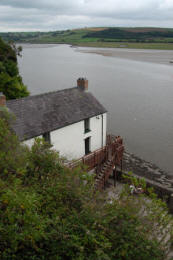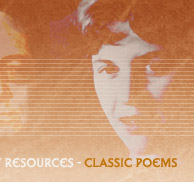Dylan Marlais Thomas is buried in the over-spill graveyard of St. Martin's Church, Laugharne, Dyfed, Wales. His grave is marked by a plain white cross. His
wife, Caitlin Thomas, is buried in the same grave and her name appears
on the reverse side of the cross.

Gravestone of Dylan Thomas
Thomas
died on November 9, 1953 while on a lecture tour of America. He had been drinking
heavily the night he died in the White Horse pub in Greenwich Village,
New York.
Later that evening he returned to his hotel room in great pain and
summonsed a doctor. Unfortunately the doctor (Dr Feltenstein) administered an abnormally large dose of morphine sulphate
and Thomas slipped into a coma. Thomas'
last words were: "I've had 18 straight whiskies......I think that's the
record." He was 39 years old. His body was brought back to Laugharne. Thomas
and Caitlin lived at The Boathouse in Laugharne in Wales from 1949 onwards after it was
purchased for them by Margaret Taylor (the wife of the historian A.J.P. Taylor).
However, Thomas
used to write in a wooden garage which stood on the cliff edge a short
distance from the house. The garage, which is still there today,
overlooks the beautiful Taf estuary.

The boathouse at Laugharne (Photo copyright Cameron Self) His routine
was to work in the mornings and then retire to the Brown's Hotel in the
village in the afternoon. Beer was his favourite tipple at this stage
and fuelled by alcohol he could be both flamboyant and entertaining.
However, his behaviour could quickly deteriorate into debauchery. He
famously defined an alcoholic as 'someone who you don't like who drinks
as much as you do'. Thomas sometimes exaggerated his drinking
exploits though and also claimed to have cirrhosis of the liver; a fact
later disproved by his autopsy. The fictional town of
Llareggub in Under Milk Wood is thought to be modelled on Laugharne
- with it's 'wood limping invisible down to the sloeblack, slow, black,
crowblack, fishingboat-bobbing sea. (If
you read Llareggub backwards you will get an insight into Thomas' sense of humour.)
Thomas' Poem on His Birthday also contains some fine descriptions
of the scenery and wildlife of the Taf estuary: 'By the full tilt river
and switchback sea/ Where the cormorants scud/In his house on stilts
high among beaks/And palavers of birds'. Thomas had great skill as a wordsmith and frequently used assonance and
consonance in his poetry. However, like A.C.
Swinburne, Thomas has sometimes been criticised for verbal dexterity
at the expense of meaning. |







